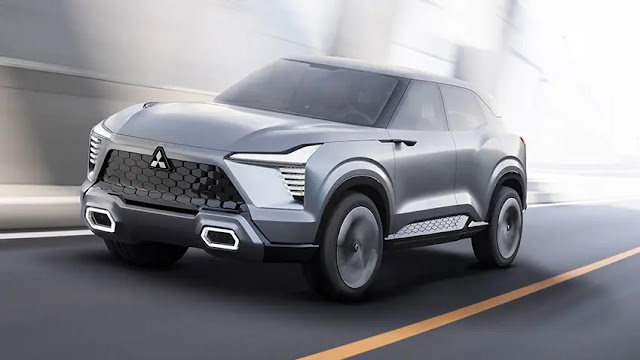Mitsubishi Pajero Sport Driven To Test It’s Limits
Mitsubishi has gone full 'Beast mode' on the Pajero Sport for 2020, giving it a new, more Triton-esque face and jamming in a whole load of new equipment, as is the Mitsubishi tried-and-tested way. And, you know what? It works very well indeed.

Well, it hasn't quite gone full-on Triton - rather, think of it as a more refined, urbane version of the Triton's aggressive Transformer face. A larger grille, smaller headlights and new LED combination indicator/cornering light/fog lights bring the beast, while tweaks to bumpers and other exterior trim (plus the addition of a rear spoiler as standard) make the Sport look lower, wider and more squared-off than before.
The polarising tail lights have come in for a refresh too, with a bolder, squarer look that sees them looking far less like clocks in a Salvador Dali painting now.

The new bumpers make the Mitsubishi Pajero 40mm longer than before, but it has lost around 20kg, with a decent chunk of that coming from the new aluminium bonnet that shaves 7.8kg off its weight.
Shaving millimetres off here and there inside the Pajero Sport has seen an increase in interior width of 25.6mm, while storage space has also increased, but the big news inside is the all-new 8-inch multi-information display that replaces the traditional dials behind the steering wheel, which is its first appearance in a Mitsubishi.
This, along with the addition of an electric tailgate, a revised and enlarged touchscreen infotainment display and remote control access via a phone app make the Pajero one of the most high-tech vehicles in the company's line up.
Okay, so its got a bunch more tech and equipment and it looks tougher, does it drive any better?

Little has actually changed on that front, but to be honest, it really didn't need to - the Pajero Sport has always ridden and handled at least as well, if not better than anything else in the large ladder-chassis ute-based SUV segment anyway, and it continues to do so.
Okay, so if you're coming from a monocoque car-based crossover-style SUV, then it is going to seem a bit agricultural in comparison, but in essence, the Pajero Sport rides and handles like a particularly impressive ute with better rear suspension - which is essentially what it is anyway.
On the open road it has a comfortable, loping ride quality that absorbs the worst of things, only occasionally getting a little brittle around the rear over broken surfaces at lower speeds.

Around town it feels firmer - like a ute - and occasionally jarring over the likes of speed bumps, but is generally a very comfortable and effortless-feeling big thing.
And make no mistake - it is big. At close to 5 metres long the Pajero Sport faces the same parking challenges that the slightly longer Triton does, plus it is also now 30mm higher than the old model too.
Still, that doesn't prevent it from being an eminently practical thing to live with, particularly thanks to its massive interior space that includes three rows of seats.
So it's still a useful thing off-road then?

Oh, yes. The increased length from the new bumpers hasn't affected the approach angle (still 30 degrees), while the departure angle has only been fractionally affected (up 0.2 degrees to 24.2) and ground clearance remains 218mm.
Mitsubishi's excellent Super Select II selectable 4WD system remains a thoroughly effortless thing to use, with easy selection via the chunky big dial in the centre console.
This is also an area where the Pajero Sport has an advantage over the Triton ute - where the Triton has an admittedly very good 6-speed automatic transmission, the Pajero Sport sticks with its utterly excellent 8-speed unit.
While the transmission is a very good thing at low speeds off the road (although it does occasionally become indecisive at on the road lower in its torque band), it truly shines at open road speeds by being remarkably fast and smooth in its shifts, and while the 2.4-litre turbo-diesel four-cylinder engine isn't exactly bristling with power, it does have a nice fat spread of torque that matches it nicely with the transmission.
No-one ever really takes these things off-road though, so what's it actually like around town?That is true, but it is nice to know that you can. Particularly if that off-road ability is paired up with a comfortable and civilised on-road demeanour, as it is in the Pajero Sport. To find out what any of the Pajero models drive like - I’d say test drive one at Group 1 Mitsubishi. It’ll be insightful and fun as hell!
The newly refreshed interior is a comfortable place, with wide, welcoming seats and pretty much every modern convenience you expect in a new vehicle.
While it is a big lad, the Pajero Sport is bristling with cameras and sensors to make life easier, including a 360-degree camera, rear cross-traffic alert and blind-spot monitoring.
This all helps to make the Pajero Sport fairly effortless to live with on a daily basis, with its commanding seating position being a particular bonus in traffic, while its excellent adaptive cruise control also helps here.

Article from https://www.stuff.co.nz/motoring/119747316/road-test-review-mitsubishi-pajero-sport



Comments
Post a Comment